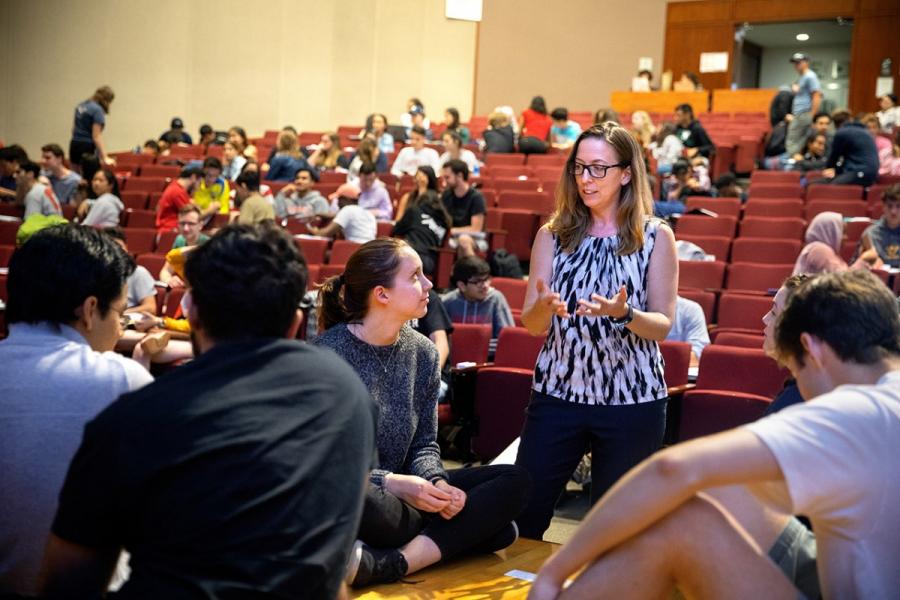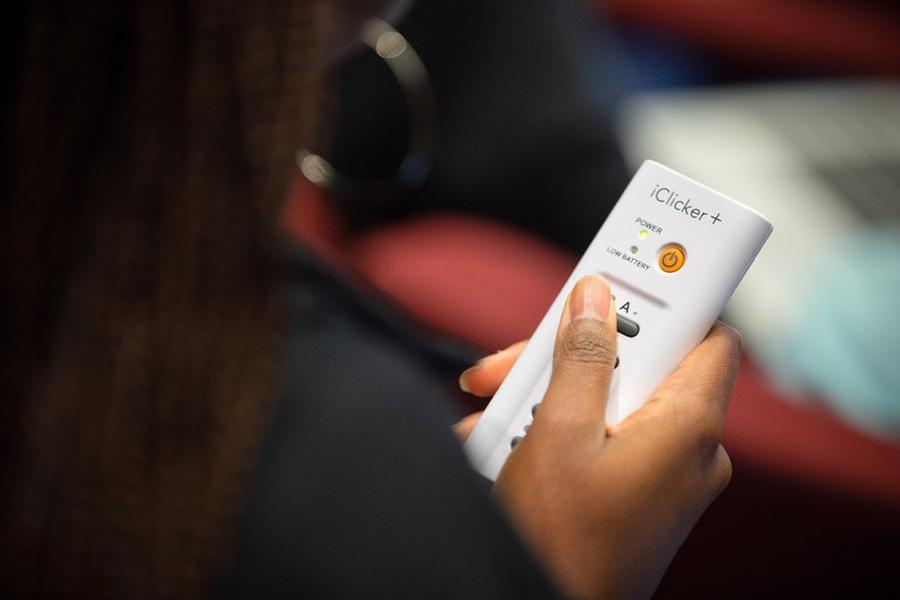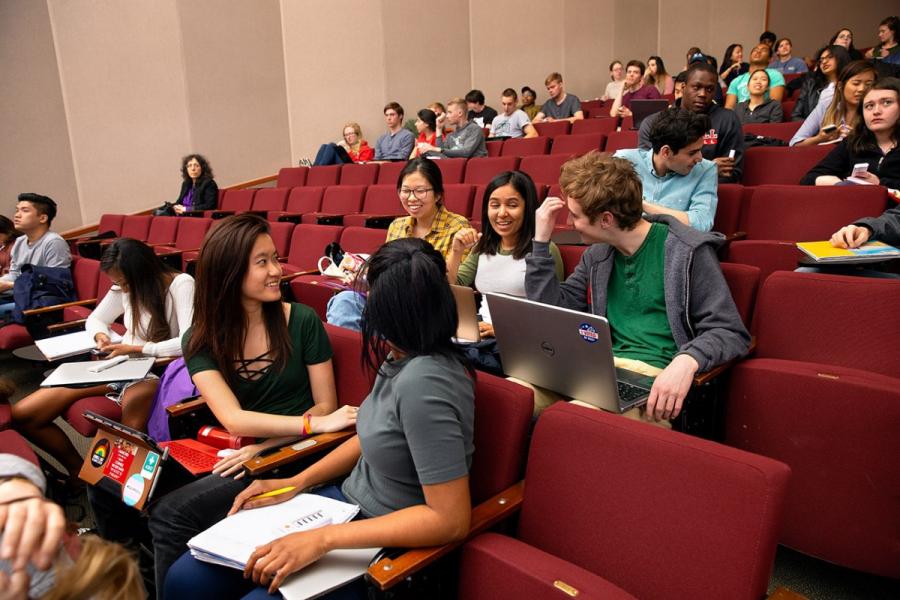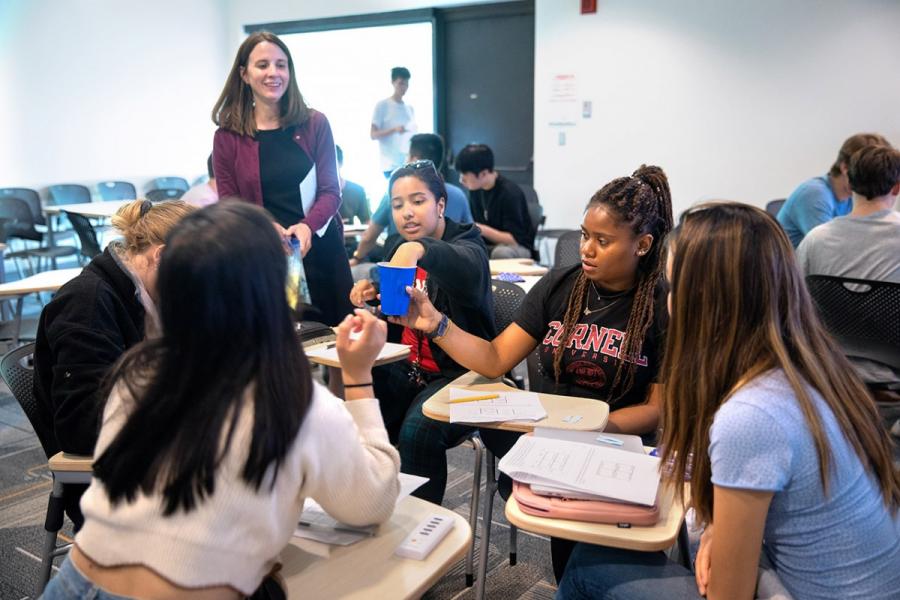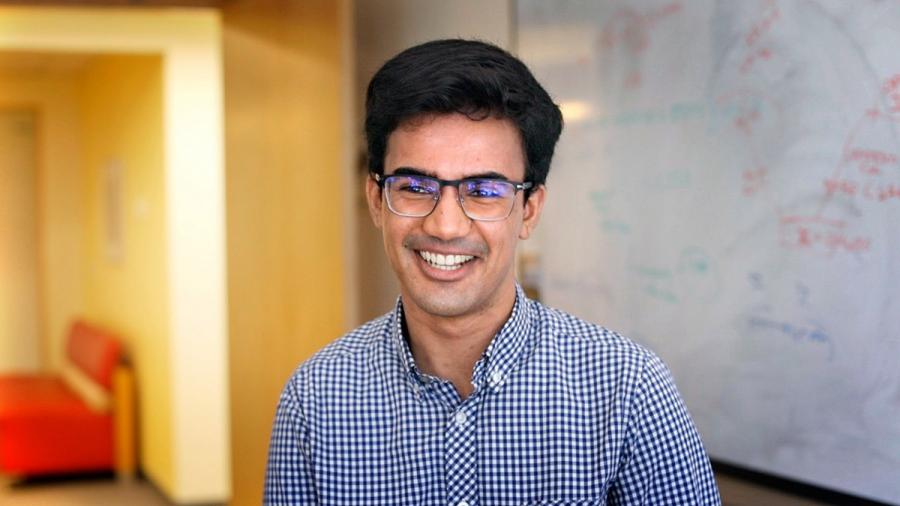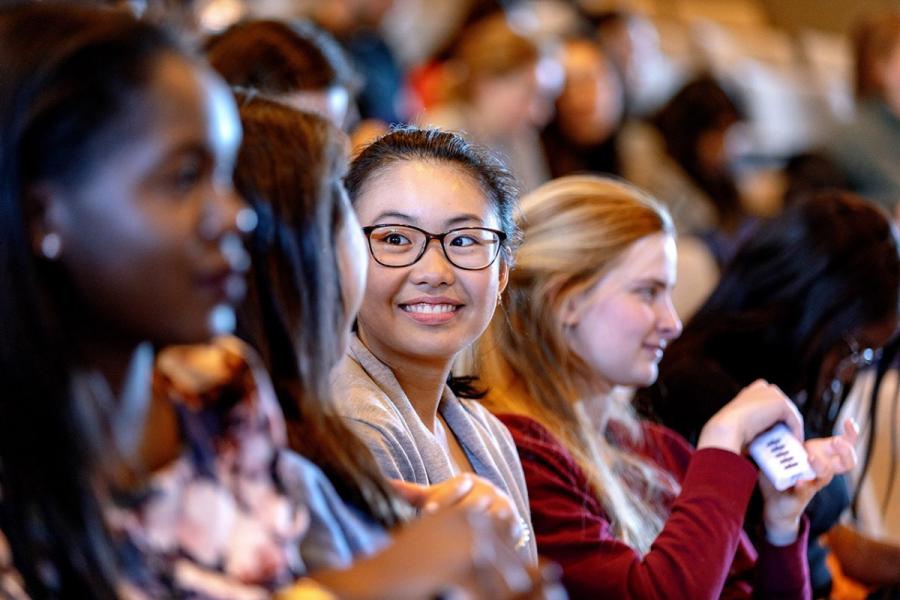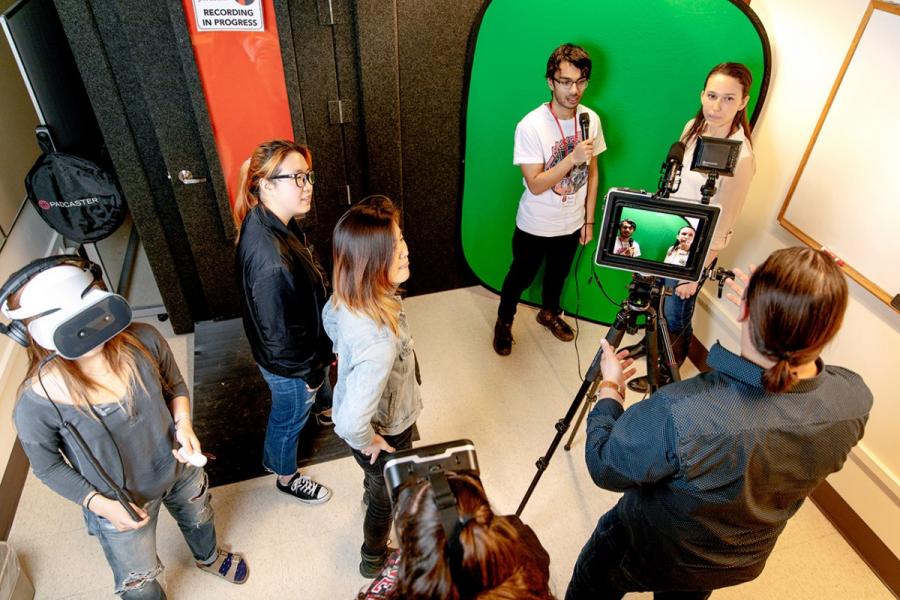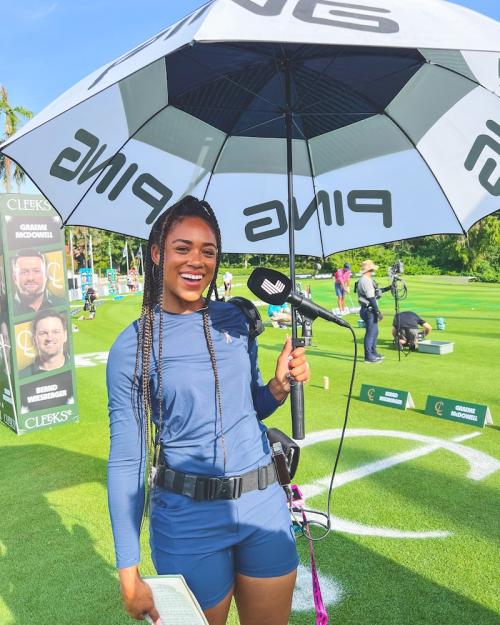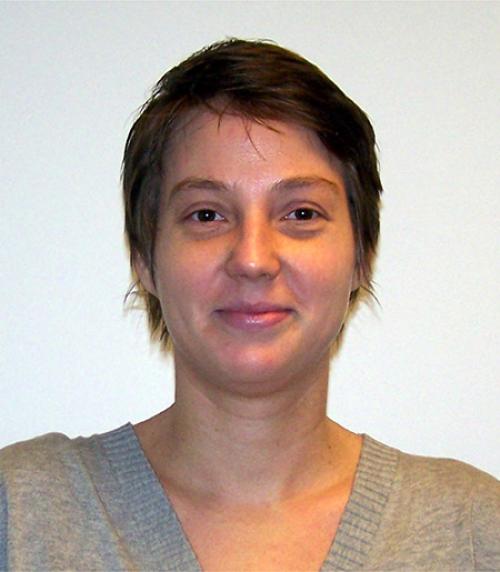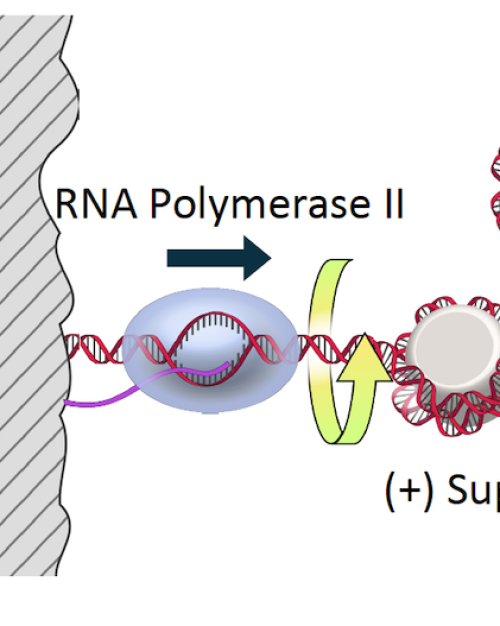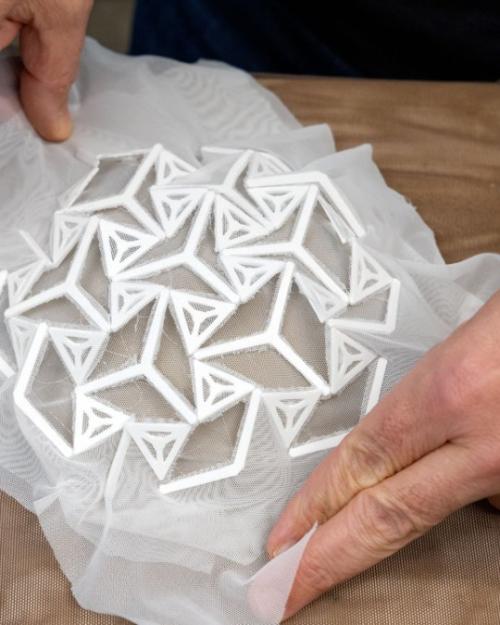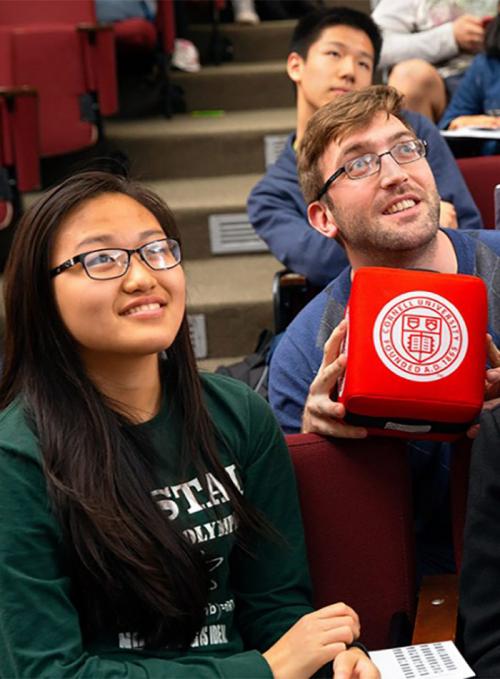The first few minutes of class in Cornell’s Introduction to Evolutionary Biology and Diversity course would seem comfortably familiar to alumni from five or 50 years ago: A couple hundred students are gathered in Call Auditorium, listening to a professor expound on population genetics or natural selection. But the lecture soon concludes, a question is posed to the students – and the class explodes into conversation and activity.
Today, teaching at Cornell is in the midst of a transformation, with faculty applying the latest research and technologies across disciplines to excite and engage students.
“We envisioned [the Center for Teaching Innovation] to be a ‘greenhouse’ for teaching innovation, a place for faculty from all colleges to bring their ideas and find support to grow them.”
Michael Kotlikoff, Cornell provost
In the evolutionary biology course (BIOEE 1780), students are clustered into teams of five – teams that remain constant throughout the semester, carefully composed based on a pre-class survey that asks about prior preparation and collaborative experience. Empty rows between the clusters are traversed by at least 10 graduate and undergraduate teaching assistants, in addition to instructors and faculty, as they engage with students.
The teams work together, debate and come to consensus. Their grades depend on it. They sometimes answer questions on scratch cards that look like lottery tickets – scratching until they reveal the right answer, with low-stakes points attached to the number of tries. They sometimes use iClickers, or an instructor may throw a “catch box,” a padded box with a microphone in it, around the hall so groups can debate with each other.
Students who have taken the course, which has been evolving for the last five years with help from Cornell’s Active Learning Initiative, call it a community, a collaborative space, a big family.
“You could just see how dedicated the instructors were to helping you learn,” says Blake Martin ’21. “They created a collaborative environment where you were really working with the content.”
Faculty members across every college at Cornell are making both small and large shifts to do this – giving students a more active role in their own learning and building community in their classrooms. In addition to the still-valuable staples of lectures and textbooks, students are asked to debate and apply concepts, to work collaboratively, and to take on the mantle of decision-makers and problem-solvers.
Veer Vekaria ’19 says these strategies not only helped him retain material but brought to life and made relevant complex concepts. In his social inequality course, taught by Kim Weeden, the Jan Rock Zubrow ’77 Professor of the Social Sciences in the College of Arts and Sciences, he debated policy solutions to societal problems with his peers.
“There were always multiple ways you could approach it,” Vekaria says. “In our groups, we were taking perspectives from different people and really hashing out what might not be as effective, or why there might be some gray area, or why the answer we arrive at might not be the perfect solution.”
Giving students these experiences and increasing engagement has many entry points – from incorporating active learning, to innovative uses of technology, to inclusive, community-building strategies. But as faculty rethink and redesign their courses, they need support.
Abby Drake, senior lecturer and Active Learning Initiative fellow in the Department of Ecology and Evolutionary Biology, works with teams to answer questions and give individual feedback in the BIOEE 1780 course.
The Center for Teaching Innovation (CTI) was established in 2017, bringing together experts on teaching and learning research and academic technologies, previously housed in different units, to provide the most comprehensive and forward-thinking resources and programming for faculty.
“We envisioned CTI to be a ‘greenhouse’ for teaching innovation,” says Provost Michael Kotlikoff, “a place for faculty from all colleges to bring their ideas and find support to grow them.”
Many initiatives have followed and dovetailed with the founding of the CTI, including upgrading the learning management system for the entire campus (moving from Blackboard to Canvas), offering a new innovation grant program for faculty, and instituting the Gateway Initiative, out of the Office of the Provost, to improve the student experience in large-enrollment, required courses.
The Active Learning Initiative (ALI) was launched in the College of Arts and Sciences in 2013 and has now expanded campuswide thanks to gifts from Alex and Laura Hanson, both Class of 1987. Today, ALI involves 16 departments and more than 70 courses across colleges, impacting thousands of students and creating a community of postdoctoral scholars dedicated to active learning and education research on campus.
“These efforts, backed by President [Martha E.] Pollack’s vision for ‘educational verve,’ have put Cornell on the cutting edge in a revolution in teaching and learning in higher education,” says Julia Thom-Levy, professor of physics and vice provost for academic innovation.
“Nationwide, we’re seeing an acceleration in the adoption of inclusive, active learning strategies.”
Mathew L. Ouellett, executive director of CTI
“Nationwide, we’re seeing an acceleration in the adoption of inclusive, active learning strategies,” says Mathew L. Ouellett, executive director of CTI. “More and more instructors across disciplines are embracing strategies backed by advances in the science of understanding how people learn.”
Broader initiatives at Cornell have coincided with efforts at the college level, including active learning programs and the College of Arts and Sciences hiring of several discipline-based education researchers. They are Natasha Holmes, the Ann S. Bowers Assistant Professor of Physics; Michelle Smith, associate professor of ecology and evolutionary biology; and Doug McKee, senior lecturer in economics, and they work in specific departments to study the ways students best learn in those disciplines.
Research that envisions how education will evolve is taking place, as well. An example is the Future of Learning Lab, directed by Rene Kizilcec, assistant professor of information science, which studies how technology and education can and do intersect. At Weill Cornell Medicine and Cornell Tech in New York City, new and innovative teaching and learning strategies also are remaking parts of the curricula.
“The world we live in is an increasingly diverse one, and our Cornell undergraduates reflect this as well,” Ouellett says. “New technologies, from virtual reality to applications for polling on our cell phones, also impact the way we teach – and what it means to be a well-educated person in the 21st century is changing. We are very lucky to have a lot of people at Cornell thinking deeply about how to respond to these changes and continue with excellence.”
The corresponding shifts in the classroom require investment, both in time and resources. Based on surveys of faculty and students, the costs are worth it; the changes, transformative. In course evaluations and focus groups, students say the new approaches are improving and deepening learning and the connections they feel with their instructors, each other and with the content, often profoundly impacting the course of their lives.
iClickers allow each student in a large lecture to participate, while also providing instructors with critical feedback about student comprehension of the material.
The benefits of active learning
For Abby Drake, senior lecturer and Active Learning Initiative fellow, and Kelly Zamudio, the Goldwin Smith Professor of Ecology and Evolutionary Biology and CTI’s 2018-19 Menschel Distinguished Teaching Fellow, the most compelling case for active learning and the changes they’ve made in the BIOEE 1780 course is in the numbers. In course evaluations, students rate their experience in the course highly and comment repeatedly about the sense of community that’s established. Most importantly for some students, that makes the difference between passing and failing.
“In the last three semesters, we’ve only had one student fail each semester, out of 200 to 300 students per course,” Drake says. In previous years, that number has been between 10 and 15 every semester.
“Statistically, we could attribute the better grades to that change in pedagogy,” Zamudio says. “Active learning introduces a different kind of guiding, a guiding that gives different people different opportunities to engage.”
The research on active learning in the BIOEE 1780 course led to a 2018 study published in Life Sciences Education, where Zamudio and her collaborators found that the changes increased science self-efficacy (one’s belief in one’s ability to succeed in a subject) for all students, and that underrepresented minority students saw significant gains in academic performance and social belonging.
Drake attributes this to the sense of community that’s built in the classroom and the opportunity that all students have to engage.
Based on answers to a pre-semester survey, students in BIOEE 1780 are assigned to teams on the first day of class and stay with their teams for the entire semester.
Michelle Smith, associate professor of ecology and evolutionary biology, observes her students in a hands-on activity in her evolution course, BIOEE 1180. Smith is one of a few faculty who research education in their disciplines – in her case, how to improve teaching in STEM courses.
“Rather than hearing one single stream from one professor, the students are hearing multiple voices and are getting a chance to talk themselves,” she says. “This way we’re reaching all of our students. There’s this attitude that if a student wants to succeed, they will. But we know it’s not a level playing field. Often, what’s holding underrepresented minorities and women back in the sciences isn’t their ability to perform. It’s the environment they’re learning in. We can change that.”
For all students, active learning also emphasizes collaborative skills that are increasingly relevant in the workplace. Vekaria, who this fall began work as a research assistant at a lab at Weill Cornell Medicine, says active learning has better prepared him for life beyond college. He took five active learning classes during his time at Cornell as a double major in biomedical sciences and biology and society, with minors in inequality studies, health policy and business.
“Most of the time in the areas I’m interested in – in the sciences and public health – either answers are not known or there are multiple answers,” he says. “Working collaboratively with our peers in the classroom to solve problems, I think it draws a pretty forceful parallel with the real world.”
The tools of engagement
Engaging students often requires new tools, and Cornell professors are using and exploring innovative materials and cutting-edge technologies – from the scratch cards and catch box in BIOEE 1780, to virtual reality and podcasts, to innovations in online spaces like the Canvas learning management system.
For Andrew Hicks, associate professor of music and medieval studies, and Courtney Roby, associate professor of classics, one tool they needed to engage their Art of Math class was not new, but rather something very, very old: monochords, a musical and mathematical instrument that was used for scientific discovery and as a teaching tool in the ancient world.
“Statistically, we could attribute the better grades to that change in pedagogy. Active learning introduces a different kind of guiding, a guiding that gives different people different opportunities to engage.”
Kelly Zamudio, the Goldwin Smith Professor of Ecology and Evolutionary Biology
Comprising one or more strings strung across a wooden box with a moveable bridge, monochords allow students to experiment with harmonic and mathematical patterns. By moving the bridge and changing the length of the strings, students discover the mathematical ratios that correspond to different harmonies.
“It’s a very active learning way of approaching the relationship between music theory and mathematics, but it’s also a historical way of approaching it,” Hicks says. “Students read treatises that are about that very instrument and use the techniques described by Greek, Latin and Arabic authors from antiquity to the Middle Ages.”
“It felt almost nostalgic, like kids playing,” says Priscilla Kim ’21. “But it was also more memorable and helped me learn the concepts.”
The team applied for a 2018 Innovation Award, funded by CTI, to have 20 instruments specially built based on Hicks’ design.
“It really brought a high-level concept down to real life, so you could think about it in a more direct, immediate way,” says Isis Encinas ’20. “A lot of the activities in the class made you feel like you were stepping into the shoes of these famous mathematicians and scientists and musicians and figuring out how they made these amazing discoveries and connections. To see that I was able to think through these things on my own made me feel a lot more capable and empowered.”
Veer Vekaria '19
The innovation award funding also enabled the hiring of two graduate students in mathematics to create online resources for the students.
“We give students a variety of ways in because you have students who learn best in all kinds of different ways,” Roby says. “Some of them learn by tinkering or running through problems on their own but with a variety of materials to work with. Some students really get it when they’re in class working through an activity or a proof with us.”
The innovative use of online space is also affording many professors more class time for active learning techniques like group work. In BIOEE 1780, students prepare for lecture by watching vodcasts – short videos that review the major concepts in the readings.
Zamudio and Drake are now pushing further into the online learning environment; with an innovation award of their own, they are creating a version of their BIOEE 1780 course, active learning included, completely online. The in-person course will continue to run every semester; the online iteration will provide students with another option and mode of learning. Comparing the two courses, Zamudio and her team, with education researcher Michelle Smith, will study how to make the online, active learning model effective and how it could benefit students.
“I don’t think there’s another online class out there that’s trying to incorporate active learning and team-based learning in this way,” Zamudio says. “We want to see how close we can get to the in-person class. How much active learning can we do in an online course? Can we really establish an online community that’s analogous to the community we have in class?”
Students engage with each other in an introductory physics course, transformed by Natasha Holmes, the Ann S. Bowers Assistant Professor of Physics, and her team.
The first iteration of the course ran in summer 2019, and the semester-length version launched this fall with the help of a second ALI grant.
Addressing classroom climate
Creating a truly student-centered classroom for optimal learning requires building an inclusive environment for an increasingly diverse student body. In 2018, CTI created a four-week, online course for the Cornell teaching community, Teaching and Learning in the Diverse Classroom.
“I would like professors to know that the students in their classes are not all the same in terms of how they behave, how they think, how they process material, how they learn,” says Jonathan Avery ’19, in one of the student videos featured in the course.“I would want a professor to know that I’m more than what you see,” Dustin Liu ’19 says in the same video. “This is probably one of the largest times of growth for us as individuals and knowing that we’re affected by the things around us, by the national climate, campus climate, by things that happen in our own lives. That’s all really important.”
More than 130 instructors took the course during the 2018-19 school year. Pre- and post-survey data show that the course not only increased instructors’ confidence in inclusive teaching and discussing difficult topics, but also increased their sense of individual responsibility in providing a welcoming environment for all at Cornell.
Sarah Wolfolds, assistant professor in the Dyson School, says the class inspired multiple revelations – the student videos provided windows into the varied student experiences at Cornell, and the readings and lessons gave her practical strategies to deal with conflict and to address events that happen outside the classroom. The prompts allowed her to reflect on her own identity and how she could be more herself as an instructor.
Mark Sarvary (behind camera), director of the Investigative Biology Teaching Laboratories, used a 2018-19 Innovative Teaching Award to create a “Bio-Imagination Makerspace,” including a whisper room, where students explore how to communicate their scientific discoveries and experiences.
“If you can bring your whole self into the classroom, students are much more likely to engage not only with you, but also with your content,” she says.
“The initiative brought together our experts in online learning and course design with experts on inclusive teaching and diversity,” says Ouellett. “But all of these things – active learning, Teaching and Learning in the Diverse Classroom, the migration to Canvas – are just different points of entry into student-centered learning.”
The cumulative impact of these changes and the aspiration is an education that empowers students and builds a stronger sense of community for all.
“The story I tell people about my Cornell experience is that I came to Cornell thinking I knew exactly what I wanted to study, but that quickly changed,” says Vekaria. “When I got to the classes that were open-ended, enhanced by active learning, classes where I was working with other people and where I was able to engage more with the instructors, I found my direction and my passion.”
